|
|
|
Sort Order |
|
|
|
Items / Page
|
|
|
|
|
|
|
| Srl | Item |
| 1 |
ID:
147680
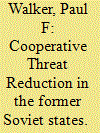

|
|
|
|
|
| Summary/Abstract |
The US Cooperative Threat Reduction (CTR) program, founded in the early 1990s to secure Soviet weapons of mass destruction (WMD)—nuclear, chemical, and biological—and promote WMD nonproliferation, has enjoyed great success. CTR has spent over $10 billion in the last twenty-five years to help eliminate thousands of nuclear warheads, dozens of nuclear submarines, 35,000 metric tons of chemical agent, and thousands of strategic missiles, bombers, and missile silos in former Soviet states. But it has also been beset with numerous funding, political, bureaucratic, technical, and planning challenges. The author reviews the history of CTR funding and legislation, discusses obstacles to implementation, and identifies five broad lessons from the program's early experiences that are applicable to future global security projects.
|
|
|
|
|
|
|
|
|
|
|
|
|
|
|
|
| 2 |
ID:
147676
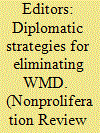

|
|
|
|
|
| Summary/Abstract |
The involvement of multiple parties makes diplomacy indispensable to the elimination of nuclear, chemical, biological and other unconventional weapons and related materials. Diplomacy is required in any attempt to address the problems of indirect control of WMD, conflicting objectives between states, conflicting priorities within states, and sometimes also the need to work in non-permissive environments. Appeals to self-interest, offers of incentives, and threats of disincentives have all been used to advance multinational efforts to manage or dispose of WMD, including elimination work.
|
|
|
|
|
|
|
|
|
|
|
|
|
|
|
|
| 3 |
ID:
147684


|
|
|
|
|
| Summary/Abstract |
Libya proved to be a unique example of WMD elimination. Unlike other WMD elimination cases, which arose out of an armed conflict that resulted in an opportunity to access and destroy a WMD program, Libya began as a cooperative WMD elimination effort that took a turn after violence erupted. The first phases of elimination arose from a combination of diplomacy, economic sanctions, and fears by the Libyan government of possible military action. This phase effectively reversed Muammar Qaddafi's attempt to develop a nuclear program and prevented the Libyan government from having access to chemical weapons when the “Arab Spring” reached Libya. The ensuing civil war brought new challenges to elimination: a breakdown in security, increased risk of chemical-weapons proliferation to violent extremists, and the discovery of a previously unknown stockpile of filled chemical munitions. Following Qaddafi's death, the second phase restarted the chemical-weapons elimination and presented new challenges still. These included the need for rapid action to complete the destruction, negotiating with an interim government, and assisting destruction without US personnel on the ground in Libya.
|
|
|
|
|
|
|
|
|
|
|
|
|
|
|
|
| 4 |
ID:
147685
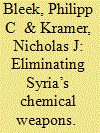

|
|
|
|
|
| Summary/Abstract |
The 2013–14 disarmament of Syria's chemical-weapons capabilities was a rare bright spot in a brutal civil war with no end in sight. The remarkable US-led, international effort to bring Damascus into the 1997 Chemical Weapons Convention, inventory its capabilities, and then verifiably destroy them is a fascinating and, to date, largely untold story. A substantial US government interagency effort centered in the Defense Department laid the diplomatic, technical, and procedural foundations for Syria's disarmament in the year prior to the August 2013 chemical-weapons attack in Ghouta that galvanized Syria's subsequent disarmament. An intrinsically interesting case, Syria's chemical-weapons disarmament has important implications for possible future WMD elimination operations elsewhere.
|
|
|
|
|
|
|
|
|
|
|
|
|
|
|
|
| 5 |
ID:
147673


|
|
|
|
|
| Summary/Abstract |
This special issue of the Nonproliferation Review results from a project funded by the US Defense Threat Reduction Agency, aiming to identify lessons learned from efforts to eliminate weapons of mass destruction (WMD) around the world. It contains edited versions of papers presented at a November 2015 workshop at the Washington, DC, offices of the James Martin Center for Nonproliferation Studies. One section covers cross-cutting themes, including the strategic, diplomatic, legal, technical, and inter- and intra-agency dimensions of elimination. The second section discusses lessons learned from work in the former Soviet states, Iraq in the 1990s, Iraq in 2003–04, South Africa, Libya, and Syria. Major observations include that the field lacks institutionalization. There are few standing bodies with funding and responsibility for WMD elimination; each case usually emerges by surprise and has ad hoc character. Different combinations of states and international agencies may be involved, bringing varied authorities and competencies to different operational environments. A generic “checklist” approach accordingly may be best suited to applying past lessons to new missions.
|
|
|
|
|
|
|
|
|
|
|
|
|
|
|
|
| 6 |
ID:
147679


|
|
|
|
|
| Summary/Abstract |
This article examines the operational, legal, organizational, and funding aspects of interagency and intra-agency coordination of weapons of mass destruction (WMD) elimination missions conducted by the United States. To illustrate the demands and complexities of these operations, it discusses the requirements of a WMD elimination mission in North Korea following the collapse of the Kim Jong-un regime. It recommends that the US Department of Defense and the broader US government re-examine and expand pre-crisis planning assumptions and associated concepts of operation, and also work to defuse interagency conflicts by establishing clear priorities and encouraging international partners to take a more active role in WMD elimination missions.
|
|
|
|
|
|
|
|
|
|
|
|
|
|
|
|
| 7 |
ID:
147677


|
|
|
|
|
| Summary/Abstract |
A state seeking to participate in a mission to eliminate weapons of mass destruction (WMD) in another state must ensure compliance with relevant domestic and international laws. This article explores the legal aspects of WMD elimination contingencies, which could take place either in the absence of a United Nations Security Council resolution or within such a context. The author focuses, in large part, on chemical weapons elimination, such as the recent endeavor in Syria, which presented the most complicated and novel legal issues associated with WMD elimination in the recent past. The article concludes by offering lessons to be considered in planning future WMD elimination missions.
|
|
|
|
|
|
|
|
|
|
|
|
|
|
|
|
| 8 |
ID:
147682


|
|
|
|
|
| Summary/Abstract |
South Africa had active nuclear, biological, and chemical weapons programs during the 1970s and 1980s. South Africa dismantled its nuclear weapon program prior to its 1991 accession to the Treaty on the Non-Proliferation of Nuclear Weapons (NPT). Similarly, it terminated its chemical weapons program prior to its 1995 ratification of the Chemical Weapons Convention. Only the dismantlement of Pretoria's nuclear weapons program was subjected to international verification—albeit ex post facto—following a 1993 decision of the International Atomic Energy Agency (IAEA) General Conference to verify the correctness and completeness of South Africa's declarations under its NPT safeguards agreement. During the 1980s, South Africa also developed and purportedly used biological weapons, violating its obligations under the 1972 Convention on the Prohibition of the Development, Production, and Stockpiling of Bacteriological (Biological) and Toxin Weapons and on their Destruction, which it had ratified in 1975. This article draws lessons from the verification of the dismantlement of these programs and makes recommendations for future verification work to confirm the elimination of weapons of mass destruction capabilities.
|
|
|
|
|
|
|
|
|
|
|
|
|
|
|
|
| 9 |
ID:
147681


|
|
|
|
|
| Summary/Abstract |
The multilateral disarmament of Iraq represents the first time since the 1918 Treaty of Versailles that victors in war imposed disarmament upon another country. In many ways, the disarmament efforts of the UN Special Commission on Iraq (UNSCOM) in the 1990s were highly successful, resulting in the discovery and elimination of most of Iraq's biological, chemical, and nuclear weapons programs, as well as their delivery systems. This article discusses the origins of Iraq's weapons of mass destruction, the establishment of UNSCOM, and UNSCOM's operational structures, capabilities, and results, as well as its eventual replacement by the UN Monitoring, Verification, and Inspection Commission—a result of political strife within the body that created it, the UN Security Council.
|
|
|
|
|
|
|
|
|
|
|
|
|
|
|
|
| 10 |
ID:
147675
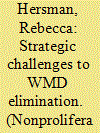

|
|
|
|
|
| Summary/Abstract |
Operations to eliminate weapons of mass destruction (WMD) are highly situation-dependent and defy easily replicable solutions and approaches. Nevertheless, by examining WMD elimination missions as they have transpired over the past several decades, we can begin to identify several consistent challenges. Learning to better prepare for these challenges—both within and across various facets of the US government as well as with our international partners—will enhance future elimination operations and their chances of success. The article concludes by asserting that military and nonmilitary approaches to these operations are not competing ideological approaches but rather reflect the complexity of the operational environment and the subsequent need for a range of legal, political, military, financial, and diplomatic tools.
|
|
|
|
|
|
|
|
|
|
|
|
|
|
|
|
| 11 |
ID:
147678
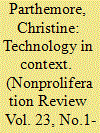

|
|
|
|
|
| Summary/Abstract |
Technology plays a central role in efforts to eliminate weapons of mass destruction (WMD). Past efforts to destroy WMD and related materials have commonly featured novel combinations of technologies designed to meet unique circumstances. In order to present the technical aspects of elimination in a context that can inform future elimination missions, this article begins by noting technology's important role. It then highlights challenges that will shape technical decisions for future missions, focusing on uncertainties, the evolution of WMD threats, the need to balance technical investments, and fighting complacency. It then offers lessons from past WMD elimination missions, including the importance of remaining innovative and agile, using a range of scenarios for planning technical options, consulting early with the full range of stakeholders who could support or challenge technical decisions, developing strong communications plans, and ensuring that plans account for critical enabling technologies. Finally, it recommends that the United States maintain elimination “on-ramps” for a range of potential future elimination missions, create a standing body to help maintain technical elimination capacity, and internationalize planning and implementation.
|
|
|
|
|
|
|
|
|
|
|
|
|
|
|
|
| 12 |
ID:
147683
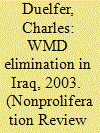

|
|
|
|
|
| Summary/Abstract |
The full picture of Iraq's weapons of mass destruction (WMD) programs became clear after 2003. The Iraq Survey Group (ISG) had extraordinary access to people, documents, and sites. The findings revealed much about Iraq's decision making regarding WMD as well as the success of UN inspection activities. Pre-war errors in process and judgments concerning Iraq's WMD must be considered in the context of the times. This is especially true regarding pre-war intelligence assessments that were based on bad analysis, insufficiently caveated, and grossly wrong.
|
|
|
|
|
|
|
|
|
|
|
|
|
|
|
|
| 13 |
ID:
147674
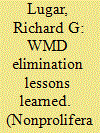

|
|
|
|
|
| Summary/Abstract |
Former Senator Richard Lugar (Republican of Indiana) provided the keynote address at the workshop held in the Washington, DC, office of the James Martin Center for Nonproliferation Studies that formed the basis of this special issue of the Nonproliferation Review. In these remarks, he discussed the importance of the Cooperative Threat Reduction programs created on 1991 legislation, co-sponsored, with Senator Sam Nunn (Democrat of Georgia). Sen. Lugar called for the maintenance and continued expansion of these programs as well as for the “creative and relentless” pursuit of new opportunities to meet evolving threats from weapons of mass destruction.
|
|
|
|
|
|
|
|
|
|
|
|
|
|
|
|
|
|
|
|
|